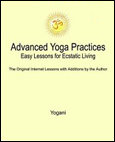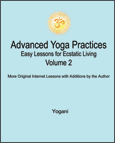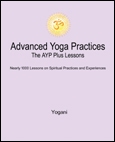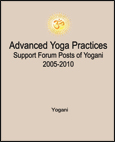|
Public Home | Plus Home | Main Lessons | Tantra Lessons | Public Forum | Plus Forum | Downloads | Books Topic Paths | Search | Training-Retreats | Testimonials | Survey | Interviews | MultiMedia | Contact | Donate |
|
Advanced Yoga Practices
Note: For the Original
Internet Lessons with additions,
see the
AYP
Easy Lessons
Books.
For the Expanded and Interactive Internet Lessons, AYP Online Books,
Audiobooks and more, see AYP Plus. Lesson 383 - Yoga Asanas (postures) Traditional or Modern? (Audio)
AYP Plus Additions:
From: Yogani New Visitors: It is recommended you read from the beginning of the archive, as previous lessons are prerequisite to this one. The first lesson is, "Why This Discussion?"
A: Yoga postures have become big business, and it is a good thing. This was discussed in some detail in Lesson 71. It is the physicality of asanas (postures) that have provided an entre for yoga into the mainstream of our physical fitness obsessed culture. Overall, it has been very beneficial, because sooner or later everyone who discovers the benefits of yoga postures will find themselves being drawn to the other seven limbs of yoga, including meditation, pranayama, etc. Such connections are wired within our nervous system, and this is why engaging in part of yoga naturally leads to all of yoga. So I am all for the yoga postures boom. It is leading everyone toward more peace, joy and energy in life, in ways that most of us could hardly have imagined even a few years ago. However, at the same time, there has been a divergence in the field of yoga postures, as you have implied, and it will be good to explore that for a clearer understanding of what is going on, and how that relates to the kinds of practices we are using in the AYP system. We can make a distinction here between "traditional" and "modern" approaches to yoga postures. The divergence can be found in the differences between these two, and in how these may relate to building a balanced practice routine that includes all eight limbs of yoga. To simplify it in this discussion, we can say that a balanced routine has two parts postures and sitting practices (pranayama, meditation, mudras, bandhas, samyama, etc.) It is the relationship between these two components we'd like to focus on here. While, even in ancient times, there have been approaches to asanas that have been intense, there has always been a recognition that asanas are part of the whole picture of yoga one of eight limbs. Such routines were done with posture holds of 10 seconds or more, sometimes much more, seeking a spiritual benefit. Pranayama and meditation (sitting practices) have always been part of the routine, as have the elements of bhakti, self-inquiry, and other aspects of the tree of yoga. So even in cases where asanas seemed to be nearly an end in themselves, they were always a preparation for sitting practices. This is the traditional approach asanas as a preparation for sitting practices. In the AYP system, 5-10 minutes of easy asanas with posture holds of 10 seconds or so has been found to be a good preparation. Modern asanas have some conspicuous differences from the traditional approach. They are usually stand-alone, not a preparation for sitting practices. And even though many of the postures may be similar or the same as the ones found in a traditional routine, the intensity and speed with which they are done may be more akin to an athletic workout than an easy routine of systematic bending and stretching. The modern routine may be much longer than is necessary for sitting practices preparation. The room temperature may also be raised to "work up a sweat." Clearly, such rigorous asana routines are not a preparation for sitting practices. They are not designed to be. So this is the main difference between traditional and modern asana practice. One is designed as a preparation for sitting practices, and the other is designed as a stand-alone fitness workout. These two modes are not nearly as far apart as might appear on the surface. For example, a modern asana routine can be slowed down and shortened to be an excellent preparation for sitting practices. So all is not lost. But let's save the long strenuous routines and "hot yoga" for at least an hour before sitting practices, or any time after. That kind of routine comes under the category of physical exercise, and we know that this is not a preparation for sitting practices. It doesn't mean we can't do it if we enjoy it. Just not as a preparation for sitting practices. Whatever asana routine we are using before sitting practices, it is suggested to end it with shavasana (corpse pose) for several minutes, to settle the body/mind down. This is the traditional transition between asanas and sitting practices, and it can be used at the conclusion of any set of postures we may be doing. As a rule of thumb, if our asana routine lowers our metabolism (relaxation of respiration and heart rate), it is good preparation for sitting practices, if not taken much beyond 5-10 minutes. More than 10 minutes done daily for an extended period of time could lead us into an energy overload, due to cumulative doubling up of the energy effects between asanas and our sitting practices. We would not do pranayama for half an hour, would we? Or meditation for an hour? Any of these excesses pursued in combination over time, could lead us into uncomfortable symptoms of energy overload. Asanas are no exception. A half hour of asanas followed by sitting practices is far more powerful than a half hour of asanas with no sitting practices. This is a lesson many asana practitioners have learned the hard way when adding powerful sitting practices. Balance is the key in building an effective integrated practice routine. Each of us is somewhat unique in this respect. This is why we place so much emphasis on self-pacing in the AYP approach. The arrival of open source full-scope yoga practices on the scene has raised some interesting possibilities for the yoga postures industry. It used to be that one had to go off and follow a sectarian teaching to learn sitting practices. This was rarely compatible with the modern teachings of asanas, which have continued to diverge in their own direction, becoming increasingly a part of the fitness industry. Due to these structural divisions, the pieces of yoga have been scattered all over the place, with little chance of connecting them, except by breaking sectarian rules and going against a major market trend in the postures industry. However, things are changing, and signs of a lessening divergence are appearing, at least in some quarters. The situation is quite different from only a few years ago. The tide is shifting toward the integration of yoga practices. It is what many practitioners want, and open source systems of practice will help fulfill this rising need. Even with the separations and divergences that have occurred in yoga over the years, practitioners have continued to benefit greatly, and many feel the internal pull toward the integration of practices in their daily routine. These days, with a few adjustments, any modern asana practitioner can add sitting practices with relative ease, with good results. Likewise, those in sitting practices have reasonable guidelines here for adding asanas from just about any teaching source, without taking on excessive risks. With self-pacing and some common sense, it can be done by anyone. The guru is in you.
Discuss this Lesson in the AYP Plus Support Forum Note: For detailed discussion on the effective integration of modern asana routines with sitting practices, see the Asanas, Mudras and Bandhas book. An enhanced asana routine containing 22 postures can be found in Lesson 383 of the AYP Easy Lessons Volume 2 book and AYP Plus Lesson 383. |
|
|
|
Join the Mail List:
AYP Retreats
eBooks - PDF, EPUB
FREE eBooks with
SAVE with Bundled
|

























